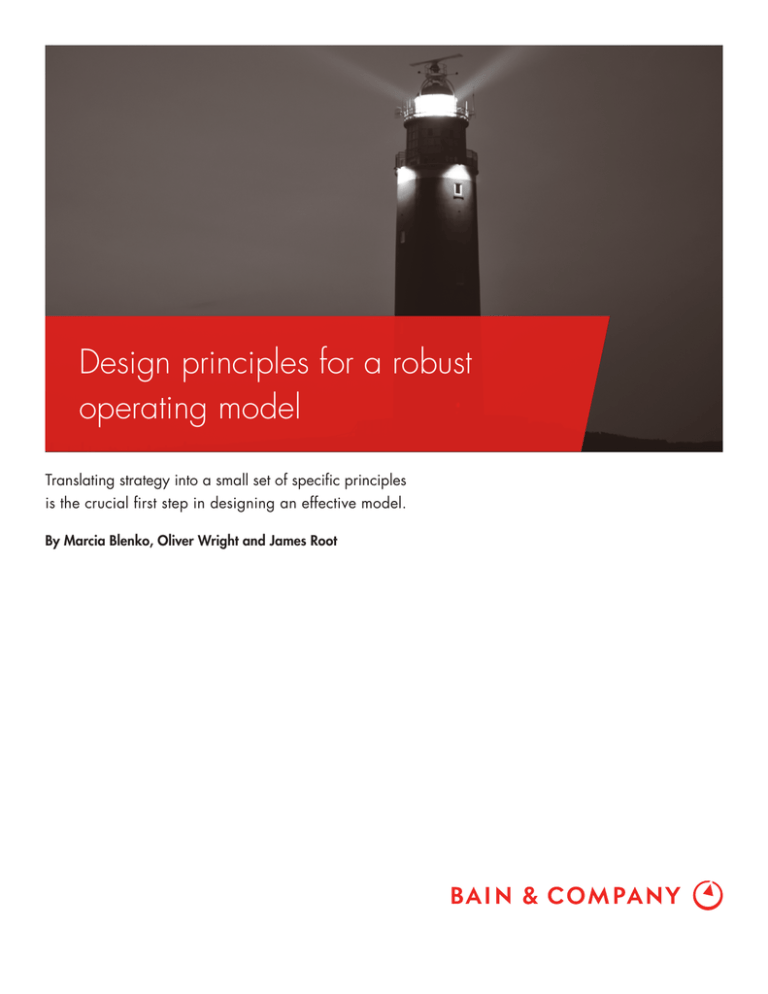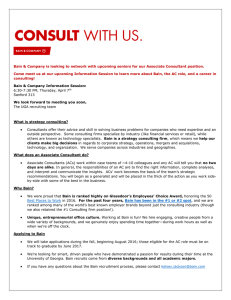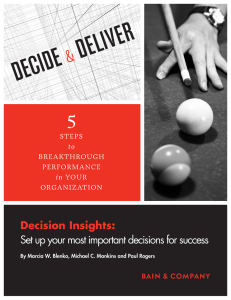
Design principles for a robust
operating model
Translating strategy into a small set of specific principles
is the crucial first step in designing an effective model.
By Marcia Blenko, Oliver Wright and James Root
Marcia Blenko is an advisory partner with Bain & Company’s Organization
practice. Oliver Wright is a partner in the practice. James Root is the leader of
the practice in Asia-Pacific. They are based, respectively, in Boston, London
and Hong Kong.
Copyright © 2015 Bain & Company, Inc. All rights reserved.
Design principles for a robust operating model
Structure follows strategy.
Bain Brief “Winning operating models that convert
strategy to results.”)
Business historian Alfred Chandler proposed his thesis
in 1962, observing that successful companies evolve
their organizational structures based on their strategies.
Chandler described how four American conglomerates that dominated their industries from the 1920s
onward shifted from a functional, monolithic organizational form to a more loosely coupled multidivisional
structure in order to address the challenges of growth
and diversification.
The crucial first step in designing an appropriate operating model is to translate the strategy into a set of design
principles—simple yet specific statements defining what
the organization must do to enable execution of the strategy. A carefully drafted set of design principles, typically
between 7 and 15 statements, helps align the leadership
team around objective criteria for designing the operating
model. This approach can apply to an entire company,
a business unit or an individual function.
Chandler’s insight that the organization must evolve to
support strategy still holds true. But the challenge has
become more complex as organizations must now be
designed to support many more growth avenues, including new products, new steps of the value chain, new
geographies, new customer segments and new channels.
Defining what matters most
Design principles specify strategic requirements that the
operating model must support. They also pinpoint aspects
of the current organization that could hinder the future
strategy and therefore must change, as well as organizational strengths that should be preserved (see Figure 1).
While principles can cover a lot of ground, they usually
address some combination of the following areas that
are most relevant to their business:
Too often, companies make one of two missteps. Some
fail to evolve their organization quickly enough to match
a shift in strategy. A European technology company, for
instance, stifled the growth of an innovative product by
keeping it highly integrated with the existing core business, which starved it of the resources, management
focus and flexibility needed to realize its potential.
The second mistake is to move full steam ahead with
a new organization design that does not match how
the business will actually create value. Consider the
financial services company that moved from multiple
independent divisions to a more integrated model in
order to encourage cross-selling. Gearing the organization around this relatively small opportunity added
complexity, slowed decision making and distracted the
divisions from realizing major growth opportunities in
their individual businesses.
So how can companies avoid these mistakes and ensure
that they forge that link between strategy and organization? They need to go beyond structure to define their
entire operating model, the blueprint for how resources
are organized and operated to deliver the strategy. All
elements of the operating model—structure, accountabilities, governance, essential behaviors as well as the
way people, processes and technology get integrated to
deliver key capabilities—must be explicitly designed
to support the strategy. With this high-level blueprint
defined, more detailed organization design can follow.
(For an overview of operating model design, see the
1
•
Focus on the specific sources of value in the business.
For example, a historically US-centered food company that was expanding internationally established
a principle to “ensure a strong focus on our highpriority growth markets.” And Olam International,
the Singapore-based commodities trading company,
has a clear principle of optimizing the supply chain
right up to the farm gate. As a consequence, Olam
makes sure that local managers give relationships
with local farmers the highest priority, because those
farmers start the value chain.
•
Call out the critical decisions. The right operating
model should make it easier to make important decisions quickly and effectively. Good principles often
highlight specific types of decisions that the new
model should facilitate. For instance, a technology
company articulated the need to “improve how
product roadmap decisions reflect customer requirements.” A consumer products company stated that
“execution of global brands, including pricing and
promotion decisions, should be highly devolved.”
•
Define scope and business boundaries appropriately,
ensuring that the model reflects opportunities for
customer-, cost- and capability-sharing across the busi-
Design principles for a robust operating model
Figure 1: Design principles articulate how the operating model will support strategic priorities and ensure
the organization works effectively
Strategic priorities
Design principles
• Ambition
Organizational assessment
• Organizational and
cultural strengths
and weaknesses
• Where to play, how to win
• Specific elements
• Heritage and values
essential to success
– Sources of growth
– Drivers of value
– Business definition
• Effectiveness of
critical decisions
– Target customers
• Gaps in key capabilities
– Critical capabilities
– Key decisions
– Cost targets
Source: Bain & Company
business with us.” A medium-sized, high-growth
company specified the need to “professionalize our
processes and improve coordination across product
areas while minimizing bureaucracy.”
nesses. A consumer products company recognized
that the market had evolved and its product should in
the future be managed globally in many respects. It
defined its principle: “Product development and
branding should be managed globally while maintaining local sales, marketing and customer insight.”
•
Where firm culture plays a major role, aspects of the
culture can be called out. One company that runs an
online marketplace and has grown through many
acquisitions has a principle to “preserve the entrepreneurial spirit that had driven our past success.”
This statement guided the new model to include
business units with leaders retaining many of their
general manager responsibilities.
Explain which capabilities are essential to fulfilling
strategic goals, such as “support a repeatable product
design process that balances customer requirements
and technical feasibility” or “allow us to easily add and
subtract businesses.” The latter principle, for instance,
would infer an operating model that maintains minimal integration across its business units.
•
One beverage company identified winning with
25-year-old male customers as a strategic priority. So
one of its design principles highlighted insights into
these customers and point-of-sale execution as two
capabilities the operating model needed to emphasize.
•
Articulate organizational strengths to preserve or
weaknesses to address. A company that had acquired
a series of businesses, all selling to the same customers, articulated a principle to “ensure that how we
go to market makes it easy for our distributors to do
2
Clarify the role of the center in leveraging scale and
expertise. A chemicals company established a principle that “the model will have a bias for simplicity and
local-market focus. Organizational elements that add
complexity or centralize activities must unambiguously add value.” Another specified that “any unit
that generates more than 80% of the demand for a
shared service will have responsibility for managing
that service.” And a global business services company
made it clear that the new model should leverage
expertise at the center with its principle that “all
major bids will be supported by a global bid team.”
Design principles for a robust operating model
mately will accelerate development of the model. Senior
leaders themselves need to spend sufficient time debating,
refining and then using the principles so that they take
full ownership. Delegation simply does not work.
Putting design principles to work
Practical use of design principles comes when a senior
executive team evaluates different operating model options. One service company had spent a decade acquiring
businesses to build a global powerhouse, but its operating
model did not fully leverage the company’s scale or global
capabilities in activities such as common purchasing or
branding. The executive team split into two factions, one
arguing for a strong country-based model while the other
pushed for a more centralized model.
Passing the “dog food” test
Across industries and countries, effective principles share
three characteristics.
First, they’re grounded in facts in order to bring objectivity
to a charged environment. When companies decide their
operating model needs to change, the discussions that follow can degrade into emotional defenses of the status quo.
Principles informed by a fact-based strategy encourage impartiality, highlighting gaps and forcing difficult choices.
So the team drew up, and aligned on, seven principles
aimed at improving local strength and flexibility while
using global scale to better advantage. Based on those
principles, senior leaders could objectively evaluate four
operating model options, and the process allowed them
to make a clear choice of a matrix model with functions
leading in select areas where scale and expertise mattered,
such as procurement and branding. The model also specified mechanisms to promote collaboration with the
countries (see Figure 2).
Second, they’re specific enough to help senior management make trade-offs. A large industrial company decided
to redesign its operating model several years ago, and the
senior team spent substantial time articulating design
principles. But the CEO worried that some principles
were too generic to help them evaluate different operating
model options. “Can any of them equally apply to a dog
food company as to us?” he asked.
Aligning the senior executive team on principles before
getting into debates on operating model solutions ulti-
Figure 2: Design principles provide the basis for evaluating operating model alternatives
Model 3 best satisfies the design principles
One service company’s design principles
Model 1:
Countrybased
Model 2:
Matrix,
countries lead
Model 3:
Matrix,
functions lead
1. Leverage scale, pool capabilities and
maximize benefits for all businesses.
2. Improve expertise, consistency and collaboration
in marketing, sales and R&D.
3. Align organization behind needs of key
global accounts.
4. Leverage scale in relationships with suppliers.
5. Improve or maintain local speed and flexibility, and
customer responsiveness.
6. Eliminate unnecessary duplication of local activities.
7. Improve ability to influence regulators at all levels.
Easier
Source: Bain & Company
3
Some improvement
Harder
Model 4:
Global
functions
Design principles for a robust operating model
His question, while tongue in cheek, crystallized a real
challenge: Generic statements such as “leverage scale”
or “create a streamlined organization” initially feel good
because people readily accept them, but they have little
explanatory power. Any successful operating model starts
with specific, clear principles that will help distinguish
between operating model choices. For a sports apparel
and equipment maker, for instance, the generic “improve
collaboration across different categories” contains less
useful direction than “make it easy for us to deliver coordinated head-to-toe apparel and footwear to stores in
time for the season.”
A beacon for employees
Ultimately, strong, specific design principles underpin all
successful operating models. Construction of a house proceeds most effectively when the owner, architect and general
contractor have detailed discussions first about the important design features and resolve potential problems before
construction starts. Similarly, writing and debating the principles for an operating model design gives senior executives
a chance to address the most vital issues, identify potential
problems and resolve ambiguity. Strong design principles
synthesize choices that leaders have made about what
matters most. That precludes unnecessary debates from
reopening later on.
Third, effective principles stay brief. The best sets of principles fit on one page. If they exceed 10 or so, it’s best to
identify the ones that should be weighted most heavily.
Moreover, they endure. One manufacturing company
that redesigned its operating model five years ago still
uses the same principles to explain the model to employees as well as to test the merit of proposed additional
organizational changes. The best principles serve as a
constant beacon when the operating model is implemented and as it evolves.
Tripping up on these three characteristics can derail the
process. And there are a few other pitfalls that leaders
should anticipate and avoid (see Figure 3).
Figure 3: Common pitfalls related to design principles
Pitfalls
Consequences
Strategy not sufficiently fact-based and specific
to inform principles
Principles not grounded in strategy, likely to be
inconsistent and misaligned, will not endure
Principles bland or indistinct
Principles don’t help make difficult operating model
choices and trade-offs
Too many principles
Operating model design solves for too many factors,
dilutes the most important ones
Principles focus too much on organizational structure
Leaders don’t consider other aspects of the model
that are essential to make structure work
Leaders not aligned around robust principles,
design debate descends into emotions and politics
Operating model is designed around the people,
not value
Leaders abandon or dilute principles
during implementation
Design loses coherence, costs increase,
execution slows
Source: Bain & Company
4
Shared Ambition, True Results
Bain & Company is the management consulting firm that the world’s business leaders come
to when they want results.
Bain advises clients on strategy, operations, technology, organization, private equity and mergers and acquisitions.
We develop practical, customized insights that clients act on and transfer skills that make change stick. Founded
in 1973, Bain has 51 offices in 33 countries, and our deep expertise and client roster cross every industry and
economic sector. Our clients have outperformed the stock market 4 to 1.
What sets us apart
We believe a consulting firm should be more than an adviser. So we put ourselves in our clients’ shoes, selling
outcomes, not projects. We align our incentives with our clients’ by linking our fees to their results and collaborate
to unlock the full potential of their business. Our Results Delivery® process builds our clients’ capabilities, and
our True North values mean we do the right thing for our clients, people and communities—always.
For more information, visit www.bain.com












